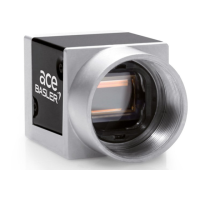AW00118508000 Camera Functional Description
Basler racer Camera Link 29
4 Camera Functional
Description
This chapter provides an overview of the camera’s functionality from a system perspective. The
overview will aid your understanding when you read the more detailed information included in the
later chapters of the user’s manual.
Each camera employs a single-line CMOS sensor chip designed for monochrome imaging. For 2k
cameras, the sensor includes 2048 pixels with a pixel size of 7 µm x 7 µm. For 4k/6k cameras, the
sensor consists of two/three 2k sensor segments with a pixel size of 7 µm x 7 µm, resulting in a total
of 4096/6144 pixels. For 8k/12k cameras, the sensor consists of 2/3 4k sensor segments with a
pixel size of 3.5 µm x 3.5 µm, resulting in a total of 8192/12288 pixels. See Fig. 10 on page 30 for
an overview of the different sensor architectures.
Line start can be controlled by trigger signals transmitted to the camera via the Camera Link
interface. Modes are available that allow the length of exposure time to be directly controlled by the
line start signal or to be set for a pre-programmed period of time.
Accumulated charges are read out of the sensor when exposure ends. At readout, accumulated
charges are moved from the sensor’s light-sensitive elements (pixels) into the analog processing
section of the sensor (Fig. 10 on page 30). As the charges move from the pixels to the analog
processing section, they are converted to voltages proportional to the size of each charge. The
voltages from the analog processing section are next passed to a bank of 12 Bit Analog-to-Digital
converters (ADCs).
Finally, the gray values pass through a section of the sensor where they receive additional digital
processing and then they are moved out of the sensor. As each gray value leaves the sensor, it
passes into an FPGA (Fig. 11 on page 31). Up to this point, all shifting is clocked according to the
camera’s internal clock speed.
The gray values are then transmitted via the Camera Link interface to the frame grabber in your
computer. Several different "Camera Link tap geometries" are available to determine how the pixel
data will be transmitted over the Camera Link interface. The user can select the desired Camera
Link tap geometry. See Section 7.2 on page 98 for more detailed information about Camera Link
tap geometries.
The user can also select from several available pixel clock speeds for the Camera Link interface.
See Section 8.1 on page 100 for more information about selecting the pixel clock speed.
